|
Wehrmacht Posts
/ Kaserne
Part 2
Part 2 features
Wehrmacht military posts in the following locations: Bavaria - Grafenwöhr, Bad
Tölz, Berchtesgaden, Bad
Reichenhall, Garmisch, Munich;
Hessen - Butzbach, Giessen, Frankfurt, Fulda,
Bad Hersfeld; Rheinland-Pfalz - Baumholder,
Baden-Württemberg - Karlsruhe.
Note: This page shows only a few such sites
... I would be very pleased to hear from anyone who would like to share similar
then-and-now photos from other Wehrmacht posts in Germany. Contact me at:
walden01 (at) comcast.net.
To view various Wehrmacht
Kaserne sites in northern Germany, visit the Forgotten
History page.
Note: After abandonment
by the military and return to the German government, many 1930s-era Kaserne are
either partially or totally torn down, so the buildings shown here in modern
photos may no longer be there.
Grafenwöhr
|
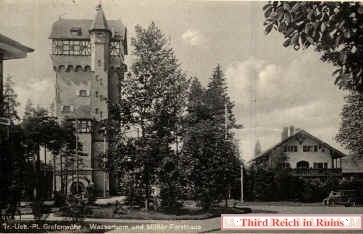
|
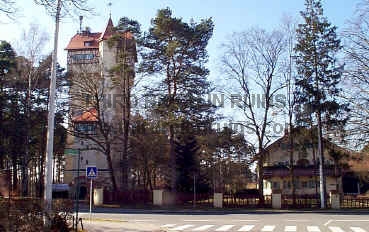
|
| The
Grafenwöhr Training Area in northeastern Bavaria was established before
World War I as an artillery live-fire range. It was greatly expanded
before and during World War II, and is now one of the major U.S. Army
live-fire range areas in Germany. The best-known site at
"Graf" is the elaborate water tower on the main post, with the
military Forsthaus (forestry house) beside it. (1936 postcard
in author's collection) (MapQuest
Map Link) |
 |
 |
| More
period postcards of the Grafenwöhr Kaserne - on the left, barracks
buildings; on the right, the section of the Kaserne for artillery
troops. |
|

|
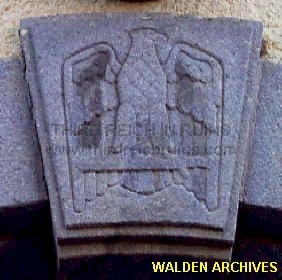
|
|
These 1938 decorations appear
above doorways on several buildings in the 620-630 range (near the Post
Exchange (PX). |
|

|

|
| This
military cemetery on the Grafenwöhr main post contains the graves of
261 Russians and Romanians who died here as prisoners of war during
World War I. |
Click here
to see views of a military ceremony in the town of Grafenwöhr in 1940.
Bad
Tölz
|

|

|
|
One of the main SS officer cadet
training academies (Junkerschule) was at Bad Tölz in the
mountains of southern Bavaria. The Bad Tölz
Junkerschule was taken over by the U.S. Army in 1945 and served various
functions, including as a Division headquarters, Special Forces
barracks, and NCO Academy. After the Americans moved out ca. 1995,
the buildings stood vacant for several years, but have recently been
remodeled into a shopping area. This remodeling included removal of the
famous entrance archway, as well as most of the buildings beyond the
main quadrangle.
(Herbert Walther, "Die Waffen-SS, eine Bilddokumentation,"
Ahnert-Verlag, n.d. (author's collection) |
|
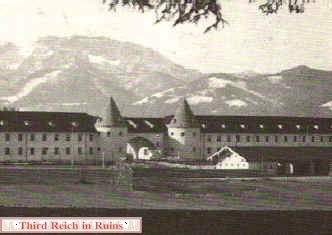
|

|
|
Distant view of the Bad Tölz
Junkerschule (Wenn alle Brüder schweigen, 1981 ed.) (MapQuest
Map Link) |
Aerial view of the Bad Tölz
complex, taken shortly after the end of the war. Under U.S. occupation,
the post initially served as headquarters for the 1st Infantry Division.
(U.S. Army photo) |
 |
 |
| Changes
and construction continue at the Bad Tölz complex. On the left is a
view of the gate building from the rear. On the right can be seen the
building at the rear of the quadrangle, not yet remodeled (visible
through the arch in the period photo below). |

Berchtesgaden

|

|
A military barracks
complex was built in the Berchtesgaden suburb of Strub in 1936-38 for the 2nd Battalion of Gebirgsjägerregiment 100, and was cited in a 1940 book on
German art as a classic example of harmonious military architecture blending into the
surroundings. The modern view is from a slightly different angle to show
Berchtesgaden's Watzmann mountain in the background. (1942-dated postcard in author's collection) (MapQuest
Map Link) |
 |
 |
| Although it has now been turned back over to the Germany military, the
Gebirgsjäger Kaserne (Mountain Troops Barracks) was used by the U.S. Army until 1995.
(period postcard) |
|

|

|
|
The period insignia over the
entry door has been modified so that the eagle holds an edelweiss flower
(symbol of the Mountain Troops), instead of a swastika. |
The Lion Monument memorializes
all those of the Mountain Troops who have lost their lives in war, in
particular the Mountain Troops of World War II. |
For other photos of Berchtesgaden area Third Reich
buildings, that were taken over in 1945 by the U.S. Army but have now been
returned to the German government, see the Berchtesgaden
pages.
Bad
Reichenhall

|

|
A military
barracks complex was built in Bad Reichenhall, north of Berchtesgaden, from
1934-36. Shown here is the
Gebirgs-Artillerie-Kaserne (for mountain artillery troops), also called the
Ritter-von-Tutschek-Kaserne. Still used by the Bundeswehr, it is now called the
Hochstaufen-Kaserne, and the swastika below the eagle at the corner of the building has been
changed to an edelweiss flower. (from period postcards; photo below-right from a private collection)
(MapQuest
Map Link) |
|

|

|

 |
 |
| 1940s
postcard views of the
Gebirgs-Artillerie-Kaserne. |
 |
 |
| Gebirgsjäger
(mountain troops) parade in the Ritter-von-Tutschek-Kaserne in these
winter views. (courtesy Stewart McCartney) |
|

|

|
|
This is the Gebirgsjäger
Kaserne, or Mackensen-Kaserne. The period soldier paintings no longer
appear on this building, which is just down the street from the
Artillerie Kaserne. This Kaserne was built for the staff and 3rd
Battalion of Gebirgsjägerregiment 100. (1940-dated postcard
in author's collection; my thanks to Torben Behrens for info about this
site) |
Garmisch
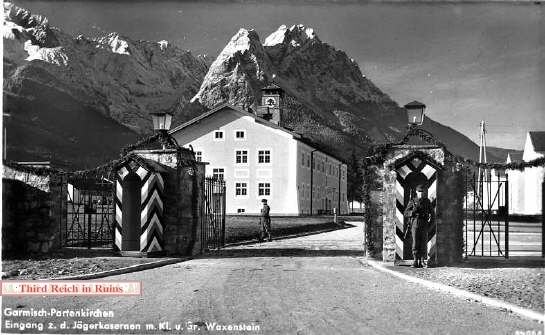 |
 |
| German Gebirgstruppen (Mountain Troops)
had two posts at Garmisch-Partenkirchen in the Bavarian Alps. Above is the
Gebirgsjäger-Kaserne, also called the General-von-Epp-Kaserne. This
post is used by the U.S. Army today as the Marshall Center. The post
shown below was the regional military hospital. It is used today to
house refugees (see also here).
(Google Maps links
- above;
below) |
 |
 |
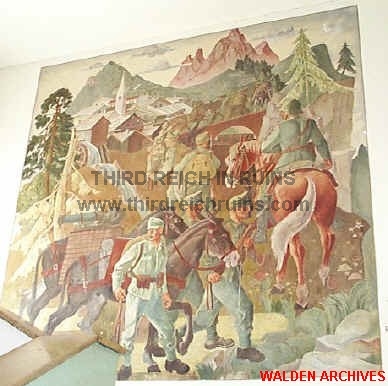
This period wall mural is in a building now used by the U.S. Army as its Post
Exchange (PX) in the Garmisch community.
(Note - This Kaserne was closed in 2006 and this building has been demolished.)
Munich
(München)
 |
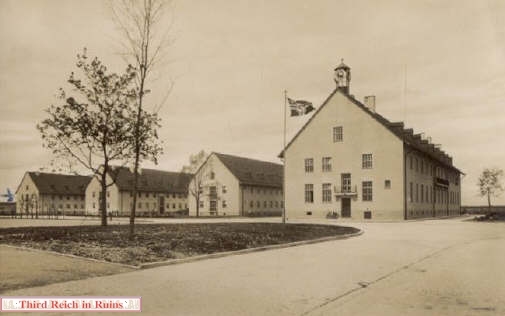 |
| Period
postcard views of two of the several Kaserne in Munich. On the left, the
Nachrichten Kaserne, built for signals units. On the right, the Kaserne
for Panzer Abwehr Abteilung 7 (Armor Replacement Battalion) in the
Munich suburb of Freimann.
Click here to see other
Kaserne in Munich. |
Butzbach
(Hessen)
|

|

|
| Butzbach
is located in the Wetterau region of Hessen, near Giessen. Before
World War I, the palace of Count Philipp III was converted into an
infantry barracks. This site continued to serve as a barracks through
World War II, after which it served the U.S. Army as Schloss Kaserne.
The area was returned to the German government in the mid-1990s, and the
military buildings were torn down in 1999. The Schloss itself is being
restored. (left - 1910-dated postcard) (MapQuest
Map Link) |
|

|

|
| Wehrmacht
infantry parade at the Butzbach Kaserne in the 1930s. (from
"Spearhead" newspaper, 21 May 1973; 33rd Armored Regiment
Assn., www.33darmor.com) |

This parade may have been on the same
occasion as the photo above. The groups in the center appear to be taking
the Oath of Allegiance, as two officers in the foreground salute. (author's
collection)
|

|

|
| A closer
view of the doorway seen in the photos above, with a close-up of the
sandstone Reichsadler. |
|

|

|
| These
two postcards show the Kaserne in the 1930s, when it was the home of
Infantry Regiment 36 (the 1930s buildings seen on the right have been
torn down). In a remarkable coincidence, under U.S. Army control from
the 1960s-1990s, this post was part of the 1st Brigade, 3rd Armored
Division, which included two battalions of the U.S. 36th Infantry
Regiment. |
Giessen
(Hessen)
|

|

|
| The city
of Giessen had several military
posts, some dating to the period before World War I. Above are two
period postcards showing the Wald-Kaserne, or Verdun-Kaserne. This post
was later used by the U.S. Army as Rivers Barracks, and is now the
Giessen Automeile. (Google
Maps link) |
|

|

|
| The
Verdun-Kaserne had several bunkers. Click here
to read more about these bunker systems. |
-
|

|

|
| The Berg-Kaserne
was built in Giessen in 1887, and other buildings were added later
during the Third Reich period. The original iron fencing above at the
main gate reads (in English): This Barracks Served from 1887 to 1918 as
Quarters for the Glorious Infantry Regiment Kaiser Wilhelm (2d Hessian
Grand Duke) No. 116. |
Frankfurt
am Main
(Hessen)
 |
 |
| Drake
Kaserne in Frankfurt am Main was the headquarters for the U.S. 3rd
Armored Division (Spearhead) from the 1950s until the early 1990s. The
entry gateway featured two Reichsadlers and an iron gate with
interlinked swastikas (this iron gate and the eagles were removed in the 1970s). (photos
courtesy Doug Stanley) |
 |
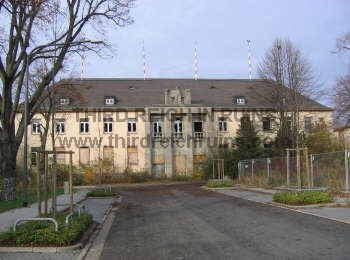 |
| On the
left, an overall view of the Drake Kaserne gate in 1958. On the right,
Gibbs Kaserne in Frankfurt as it appeared in 2006, complete with Reichsadler still on
one building. (from the U.S.
Army in Germany site) |
 |
Fulda
(Hessen)
 |
 |
| In 1937
a Kaserne was built in Fulda for artillery observation units. The major
tenant unit during most of the Cold War was the Regimental HQs and 1st
Squadron of the 14th Armored
Cavalry Regiment from 1951 until it was reflagged as the 11th Armored
Cavalry Regiment in 1972. Under U.S. use, the Kaserne was known as Downs
Barracks. In 1993, following the end
of the Cold War mission, the Kaserne was returned to German control, and
it now houses several government and police offices, and small
businesses. (Click here to
visit OP Alpha, one of the border sites guarded by 1/11ACR.) (US
Army in Germany page; thanks to Max Whipps for further info) (MapQuest
Map Link) |
 |
 |
| Then and
now views of the main gate building. (period postcard) |
|

|
The
Kaserne was originally named in honor of Gen. Erich Ludendorff, a World
War I hero (and early member of the Nazi Party), and the original plaque
still remains at the main gate.
Ludendorff was one of the major participants in
the 1923 Munich putsch, in which the early Nazi Party attempted
to take over the Bavarian government. Ludendorff marched with Hitler to
the Feldherrnhalle,
where he was the only marcher to advance against the line of police
without retreating.
|
 |
 |
| Period
tunnels still exist beneath the parade field of the former Ludendorff
Kaserne. |
Bad
Hersfeld (Hessen)
 |
 |
| In 1937
a Kaserne was built in Bad Hersfeld for motorcycle and armored car units. The major
tenant unit during most of the Cold War was the 3rd Squadron, 14th Armored
Cavalry Regiment from 1951 until it was reflagged as the 11th Armored
Cavalry Regiment in 1972. Under U.S. use, the Kaserne was known as McPheeters Barracks. In 1993, following the end
of the Cold War mission, the Kaserne was returned to German control, and
it now houses several small businesses, government offices, and a school. (Click
here to
visit OP India, one of the border sites guarded by 3/11ACR.) (period
postcards; thanks to Max Whipps for further info) (MapQuest
Map Link) |
 |
 |
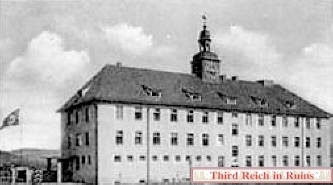 |
 |
| The
former McPheeters Barracks is one of the best-preserved Wehrmacht/Cold
War posts, that is no longer in use by the military. The Kaserne area
is now called the Gewerbepark Hohe Luft. (period postcards) |
 |
 |
 |
 |

Click here
to visit a site about McPheeters Barracks in the 1960s and 1970s.
Karlsruhe
(Baden-Württemberg)
 |
 |
| Rhein-Kaserne
was built in the Karlsruhe suburb of Knielingen from 1935-38. It was
occupied by the U.S. Army as Gerszewski Barracks. The photo on the left
shows the Hoheitszeichen on a building beside the gate - remains of the
swastika still appeared under U.S. Army control in the 1950s and 1960s.
The eagle remained until the Kaserne was torn down in 2004. (from
the U.S.
Army in Germany site and the 79th
Engineer Battalion site) |
 Back to Wehrmacht
Posts Part 1
Back to Wehrmacht
Posts Part 1
 Continue to Wehrmacht
Posts Part 3
Continue to Wehrmacht
Posts Part 3
 Return to the "Third
Reich in Ruins" homepage
Return to the "Third
Reich in Ruins" homepage
|
